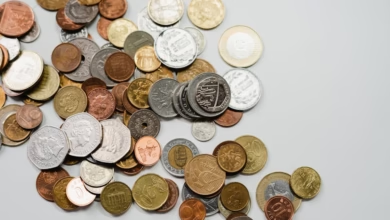The Essential Guide to Gold and Currency Exchange: Exploring Gold’s Role in Forex and Global Trade Dynamics

In an ever-evolving global economy, the role of gold remains a pivotal topic for investors and traders alike. As a safe haven asset, gold has historically offered stability and security during times of economic uncertainty, making it a crucial element in forex trading and global trade dynamics. With gold prices fluctuating due to various factors, including geopolitical tensions and inflation, understanding the gold market trends is essential for anyone involved in gold investment.
This article delves into the multifaceted relationship between gold and currency exchange, exploring how central banks manage gold reserves and their influence on global currency dynamics. We will also analyze current gold market trends, investment opportunities in gold futures and gold ETFs, and the implications of gold mining practices on sustainability. From the allure of gold jewelry and collectibles to the rise of gold and cryptocurrency, we will provide a comprehensive overview of gold's role in shaping global trade. Join us as we embark on a journey through the intricate world of gold, where each nugget of information can significantly impact investment decisions and trading strategies.
- 1. The Safe Haven Asset: Understanding Gold's Role in Forex and Global Trade
- 2. Gold Market Trends: Analyzing Gold Prices and Investment Opportunities
- 3. Central Banks and Gold Reserves: The Impact on Global Currency Exchange and Trade Dynamics
1. The Safe Haven Asset: Understanding Gold's Role in Forex and Global Trade
Gold has long been regarded as a safe haven asset, particularly in times of economic uncertainty and market volatility. Its intrinsic value and historical significance make it a crucial player in the forex market and global trade. As investors seek to protect their portfolios from inflation and currency fluctuations, gold investments become increasingly appealing. This is evident in the rising demand for gold ETFs, which provide a convenient way to gain exposure to gold prices without the need for physical gold ownership.
Central banks around the world hold substantial gold reserves as a safeguard against economic crises and currency devaluation. The gold standard, once a dominant monetary system, illustrated gold's role in stabilizing currencies. Although no longer used, the principles of the gold standard continue to influence modern monetary policy and the strategies employed by central banks that still accumulate gold.
In addition to its role in forex, gold is an essential component of global trade. Gold mining operations contribute significantly to economies, and sustainable gold mining practices are increasingly prioritized to minimize environmental impacts. Moreover, gold recycling has gained traction as a means of meeting global gold demand while addressing sustainability concerns.
The gold market is characterized by various trends, including fluctuations in gold prices and the growing interest in gold futures among traders. The diversification offered by gold coins, gold bullion, and luxury gold items further highlights the asset's versatility. Collectors also seek gold collectibles and coins as tangible investments that can appreciate over time.
As the landscape of investing evolves, the relationship between gold and cryptocurrency has become a topic of interest. Many investors view gold as a hedge against the volatility often seen in digital currencies, reinforcing its status as a stable asset during turbulent times.
Overall, gold's multifaceted role in forex and global trade underscores its enduring appeal as a safe haven asset. As market dynamics continue to shift, understanding gold market analysis and trends will be essential for investors looking to navigate the complexities of both traditional and digital asset investments.
2. Gold Market Trends: Analyzing Gold Prices and Investment Opportunities
The gold market has always been a focal point for investors, especially during periods of economic uncertainty. Analyzing current gold market trends is essential for identifying investment opportunities and understanding how gold prices can fluctuate in response to various factors.
In recent months, gold prices have shown resilience, often reacting positively to global economic instability and inflation concerns. As central banks continue to hold significant gold reserves, the demand for gold as a safe haven asset remains robust. This trend is particularly evident during times of geopolitical tension, where investors seek stability through gold bullion, gold coins, and gold bars.
Investment in gold has evolved, with gold ETFs (Exchange-Traded Funds) becoming increasingly popular. These funds provide investors with easy access to gold without the need to hold physical gold. However, traditional forms of gold investment, including gold jewelry and collectibles, still attract interest, especially luxury gold items. Investors are also becoming more aware of sustainable gold mining practices, which aim to reduce the environmental impact of gold production.
Moreover, gold futures contracts offer another avenue for investment, allowing traders to speculate on future gold prices without the need to own the physical asset. This can be particularly appealing in a volatile market. Additionally, gold recycling plays a significant role in supplying the market with refined gold, as it allows for the reclaiming of valuable materials from old jewelry and electronics.
The relationship between gold and cryptocurrency has also gained attention, with some investors viewing cryptocurrencies as a modern alternative to gold. However, many still favor gold due to its long-standing history as a store of value, especially when considering its role during inflationary periods.
In conclusion, analyzing gold market trends reveals a dynamic landscape filled with various investment opportunities. Whether through physical gold, gold ETFs, or gold futures, investors can leverage the unique characteristics of gold to enhance their portfolios. As global gold demand continues to evolve, staying informed about market trends is crucial for making sound investment decisions in the ever-changing financial landscape.
3. Central Banks and Gold Reserves: The Impact on Global Currency Exchange and Trade Dynamics
Central banks play a pivotal role in the dynamics of global currency exchange and trade, and their management of gold reserves significantly impacts these markets. Historically, gold has been viewed as a safe haven asset, providing stability during economic uncertainty. As a result, many central banks maintain substantial gold reserves, which serve as a buffer against currency fluctuations and inflation.
Gold reserves are crucial for central banks as they help instill confidence in a nation's currency. When central banks hold significant amounts of physical gold, it can enhance the perceived value of their fiat currencies. This is particularly important during periods of economic instability or rising inflation, where gold is often viewed as a hedge. The relationship between gold and inflation has been closely monitored, as rising inflation typically drives investors towards gold investments, leading to an increase in gold prices.
Moreover, central banks' actions in the gold market can influence global gold demand and market trends. For instance, when a central bank decides to increase its gold reserves, it can lead to a surge in gold prices due to heightened demand. Conversely, if a central bank sells off a portion of its gold reserves, it may contribute to a decrease in gold prices. This dynamic is often analyzed through gold market analysis, assessing how central bank decisions shape the broader financial landscape.
The rise of gold ETFs (Exchange Traded Funds) has also transformed the gold market. These financial instruments allow investors to gain exposure to gold without the need for physical gold ownership. Central banks' gold holdings can affect the performance of these ETFs, as fluctuations in gold prices directly impact their value. Additionally, central banks' strategies concerning gold futures play a role in shaping expectations and influencing market sentiments.
Central banks are increasingly focusing on sustainable gold mining practices to address environmental concerns associated with gold production. This shift not only supports global sustainability efforts but also enhances the appeal of gold as a responsible investment. Furthermore, issues such as gold smuggling and illegal gold trade pose challenges to regulatory frameworks and impact global trade dynamics.
In the realm of luxury gold, including gold jewelry and gold collectibles, central banks’ policies can influence consumer behavior and spending. As central banks adapt their gold strategies, they also shape market sentiments regarding gold bars, gold coins investing, and gold refining practices. The interplay between central banks and the gold market is multifaceted and reflects broader economic conditions, making it a critical area for investors and policymakers alike to monitor.
In summary, central banks and their gold reserves significantly impact global currency exchange and trade dynamics. By managing their gold holdings judiciously, they play an essential role in maintaining market stability and influencing gold market trends. Understanding this relationship is vital for those engaged in gold investment, gold mining, and the broader financial markets.
In conclusion, gold continues to play a pivotal role in forex and global trade, acting as a safe haven asset amid economic uncertainties. As we have explored, the dynamics of gold prices and market trends are influenced by various factors, including central bank policies and global demand. The strategic significance of gold reserves held by central banks underscores its importance in shaping currency exchange rates and stabilizing economies.
Investors are increasingly turning to gold investment vehicles such as gold ETFs and gold futures, reflecting a growing confidence in gold as a hedge against inflation and market volatility. Additionally, the rise of sustainable gold mining practices is crucial in meeting global gold demand while addressing environmental concerns.
As the landscape of gold trading evolves, from physical gold and gold bullion to innovative technologies in gold refining and recycling, opportunities abound for both seasoned investors and newcomers. Understanding these facets of the gold market, including the appeal of gold coins and collectibles, is essential for making informed decisions in a complex financial environment.
Ultimately, the enduring allure of gold, from luxury gold jewelry to the potential intersection with cryptocurrency, ensures that it remains a vital component of the global economic framework. By staying attuned to gold market analysis and trends, investors can navigate this multifaceted asset class effectively, leveraging its unique attributes to bolster their financial portfolios.
References:
[Include relevant sources here]




